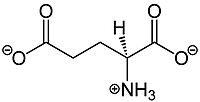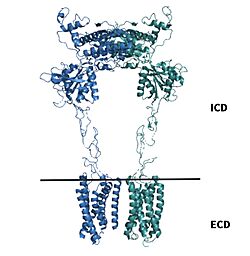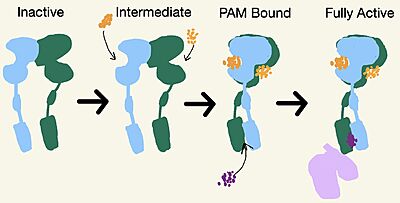Sandbox Reserved 1703
From Proteopedia
(Difference between revisions)
| Line 34: | Line 34: | ||
====G-Protein Recognition==== | ====G-Protein Recognition==== | ||
| - | Transition to the active state also reorients helix 3 in both monomers to enable binding to the G-protein: Yet only one chain is required for full receptor activation. The intracellular region of helix 3 contributes the main interactions with the α-subunit of the G-protein. Intracellular Loop 2 also builds a polar interaction network with the G-protein through its ionic interactions with the <scene name='90/904308/Binding_recognition_site/2'> α-subunit</scene> of the G-protein. | + | Transition to the active state also reorients helix 3 in both monomers to enable binding to the G-protein: Yet only one chain is required for full receptor activation. The intracellular region of helix 3 contributes the main interactions with the α-subunit of the G-protein. Intracellular Loop 2 also builds a polar interaction network with the G-protein through its ionic interactions with the <scene name='90/904308/Binding_recognition_site/2'> α-subunit</scene> of the G-protein. The ionic interactions formed further destabilize the inactive conformation<ref name="Lin"/>. |
====G-protein Binding==== | ====G-protein Binding==== | ||
| - | The PAM induced downward shift of helix | + | The PAM induced downward shift of helix 4 coupled with the reorientation of the transmembrane domain to a TM6-TM6 asymmetric interface, opens up a cleft on the intracellular surface of the receptor. This cleft allows a <scene name='90/904308/Hook_region/1'>hook-like region</scene>, from the last 4 terminals of the α-subunit of the G-protein, to move in adjacent to helix 4 in the transmembrane domain. Within this interaction, <scene name='90/904308/Hook_region_recognition/2'>C351</scene> on the hook participates in hydrophobic interactions with Intracellular loop 2 and helix 4. These interactions allow the C-terminal region of the G-protein α-subunit to bind in the shallow groove formed by intracellular loops 2 and 3 and residues on helices 3 and 4<ref name="Lin" />.The receptor is now <scene name='90/904308/Active_structure/3'>fully active</scene> with the dimer coupled only to one G-protein. The VFT is in the closed conformation and the TMD helices are also reoriented in both monomers to form an asymmetric dimer interface. |
==Clinical Relevance== | ==Clinical Relevance== | ||
Revision as of 02:41, 19 April 2022
Contents |
Metabotropic Glutamate Receptor 2
| |||||||||||
3D Structures
7mtq, mGlu2 inactive
7mtr, mGlu2 PAM bound
7mts, mGlu2 active
References
- ↑ 1.0 1.1 1.2 1.3 1.4 1.5 1.6 1.7 1.8 Lin S, Han S, Cai X, Tan Q, Zhou K, Wang D, Wang X, Du J, Yi C, Chu X, Dai A, Zhou Y, Chen Y, Zhou Y, Liu H, Liu J, Yang D, Wang MW, Zhao Q, Wu B. Structures of Gi-bound metabotropic glutamate receptors mGlu2 and mGlu4. Nature. 2021 Jun;594(7864):583-588. doi: 10.1038/s41586-021-03495-2. Epub 2021, Jun 16. PMID:34135510 doi:http://dx.doi.org/10.1038/s41586-021-03495-2
- ↑ 2.0 2.1 2.2 2.3 Seven, Alpay B., et al. “G-Protein Activation by a Metabotropic Glutamate Receptor.” Nature News, Nature Publishing Group, 30 June 2021, https://www.nature.com/articles/s1586-021-03680-3
- ↑ Du, Juan, et al. “Structures of Human mglu2 and mglu7 Homo- and Heterodimers.” Nature News, Nature Publishing Group, 16 June 2021, https://www.nature.com/articles/s41586-021-03641-w.>
- ↑ 4.0 4.1 “Metabotropic Glutamate Receptor.” Wikipedia, Wikimedia Foundation, 27 Mar. 2022, https://en.wikipedia.org/wiki/Metabotropic_glutamate_receptor
- ↑ \“Schizophrenia.” National Institute of Mental Health, U.S. Department of Health and Human Services, https://www.nimh.nih.gov/health/topics/schizophrenia
- ↑ 6.0 6.1 Ellaithy A, Younkin J, Gonzalez-Maeso J, Logothetis DE. Positive allosteric modulators of metabotropic glutamate 2 receptors in schizophrenia treatment. Trends Neurosci. 2015 Aug;38(8):506-16. doi: 10.1016/j.tins.2015.06.002. Epub, 2015 Jul 4. PMID:26148747 doi:http://dx.doi.org/10.1016/j.tins.2015.06.002
- ↑ 7.0 7.1 7.2 7.3 Muguruza C, Meana JJ, Callado LF. Group II Metabotropic Glutamate Receptors as Targets for Novel Antipsychotic Drugs. Front Pharmacol. 2016 May 20;7:130. doi: 10.3389/fphar.2016.00130. eCollection, 2016. PMID:27242534 doi:http://dx.doi.org/10.3389/fphar.2016.00130
Student Contributors
Frannie Brewer Ashley Wilkinson




